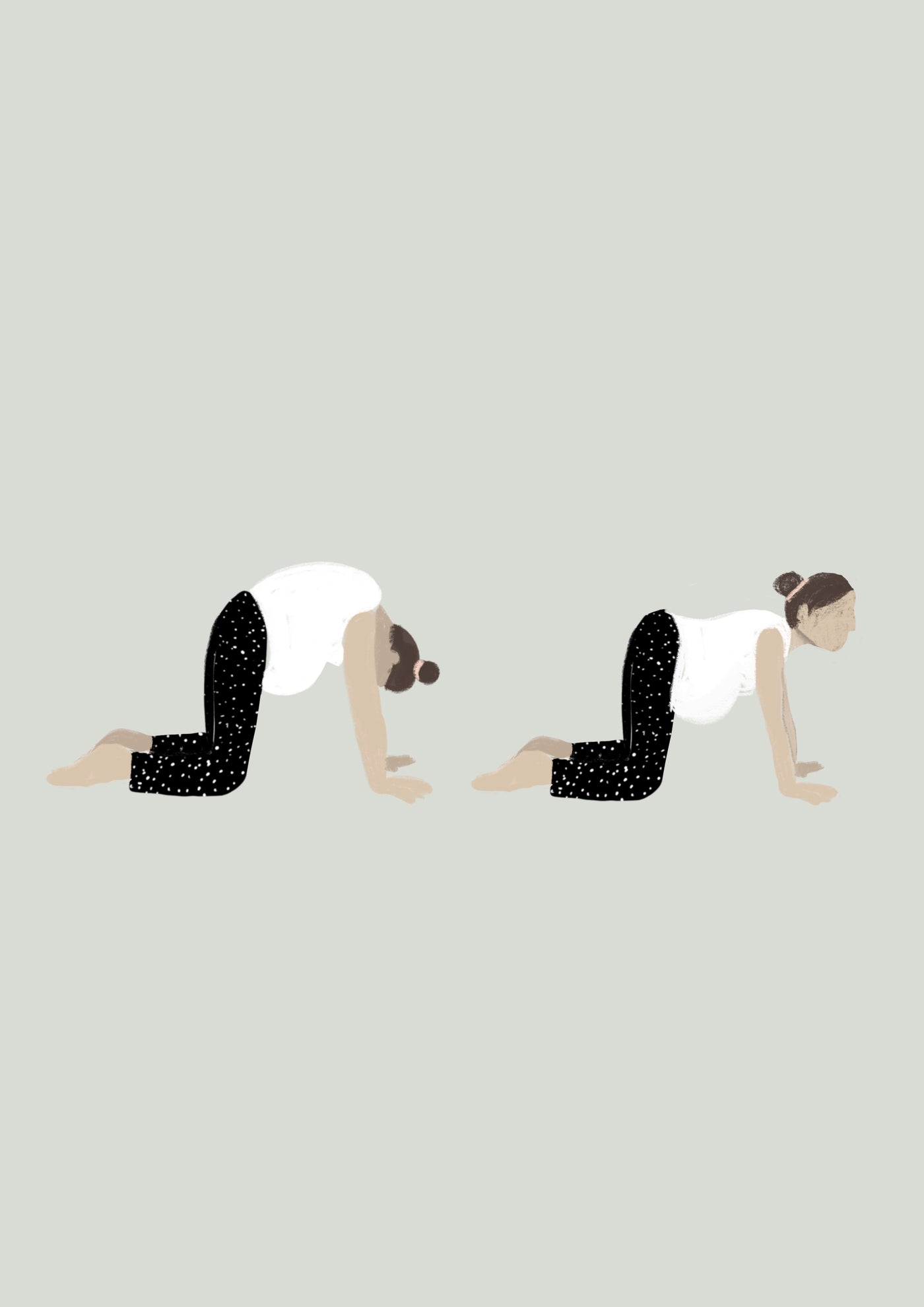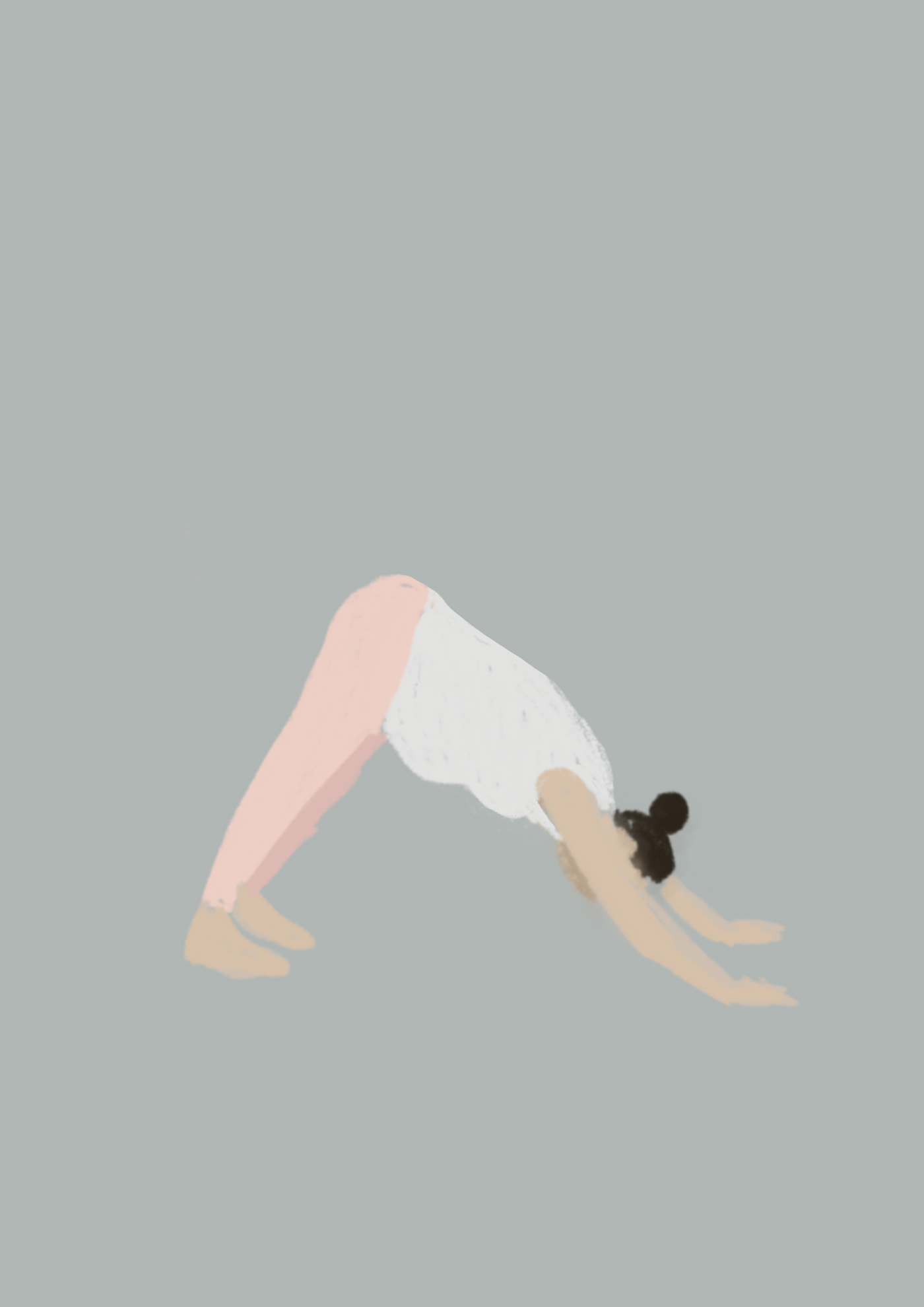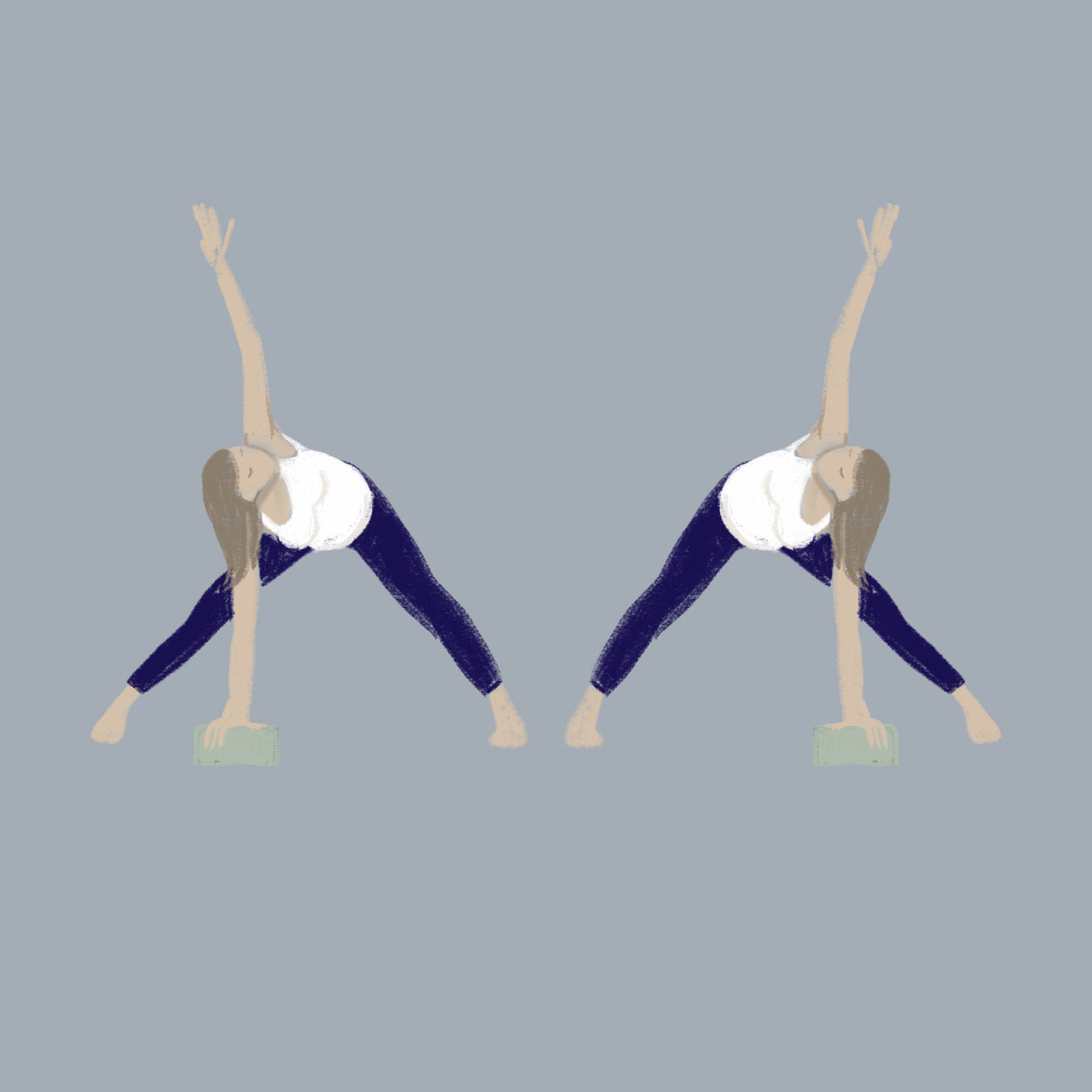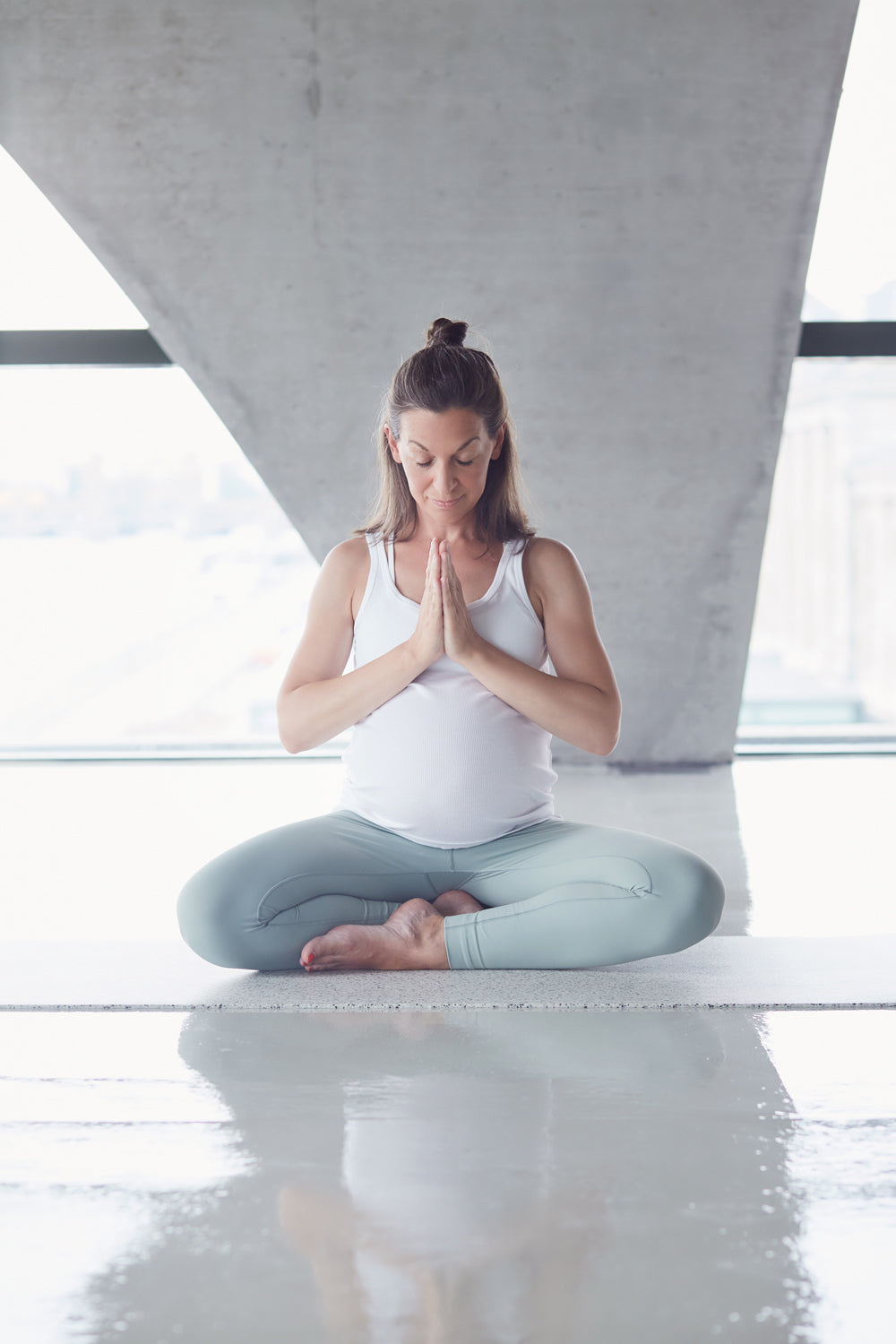In many ways, yoga is a great companion throughout pregnancy and a holistic preparation for childbirth. Yoga helps to engage in this phase of transformation - physically, mentally and emotionally. Practicing yoga is about nurturing and connecting with yourself and your baby.
Targeted, strengthening and opening asanas, a calming pranayama and a relaxing meditation deepen body awareness and female intuition. Symptoms typical of pregnancy can also be alleviated or avoided through targeted exercises. Relaxation, calm, balance, as well as the quality of letting go and acceptance are the essential aspects of pregnancy yoga. Powerful sequences are always about experiencing tension in a targeted manner. The exercises on the mat serve as a mirror for dealing with stress and challenges in everyday life. All of these aspects serve to get you in the mood for the day of the birth, both internally and physically, and to look forward to it with confidence, anticipation and serenity.
It is important to know that prenatal yoga is different from normal yoga classes! Many of the asanas and breathing exercises from conventional yoga classes are not suitable for pregnancy and should be adapted. Because not every asana is suitable and advisable for every pregnant woman, in every trimester.
The first trimester (1st to 12th week) is not called the adjustment phase for nothing. Hormonal changes, emotionality, tiredness or nausea can characterize this initial period. This should also be reflected in a more adapted, gentler practice. So calmly lower the performance requirements, rather consciously observe the changes and breathe deeply.
The second trimester is the phase of well-being, vitality and strength for many pregnant women (13th to 24th week). Many moms-to-be are now looking forward to a powerful yoga class with phases of relaxation.
Finding the balance between activity and rest is one of the most important issues of this time. The growing belly also requires further adjustments to individual asanas.
The third trimester is the phase of the greatest physical and sometimes emotional challenge leading up to childbirth preparation (25th to 40th week). Due to the additional weight and the size of the stomach, the freedom of movement is now even more restricted. Sometimes minor or major physical complaints (symphysis, water retention, etc.) also occur during this time. In practice, energetic movements should alternate with supported, gentle stretching and longer relaxation phases. The focus is on the qualities of letting go, trust, devotion, rest and relaxation. Breathing exercises and tones, as well as meditation and relaxation exercises, are part of a well-rounded pregnancy class in order to prepare yourself internally for the day of the birth and to bond with the baby.
If you never practiced yoga before you became pregnant or only very infrequently, you should definitely attend prenatal classes during pregnancy. If you already had an advanced yoga practice before you became pregnant, you may be able to after the first trimester
continue a more powerful practice - with modifications for pregnant women. In principle, however, the following always applies:
"Less is more!"
Especially in the last few weeks and months you may have switched to online yoga classes or are currently looking online for a suitable offer for prenatal yoga. It is all the more important that you take good care of yourself and your baby, honor the limits and are familiar with the basics of the practice as well as the basic dos and don'ts in pregnancy yoga.
DOS
DO'S IN PRENATAL YOGA
Which asanas are "allowed" and what should you pay attention to in your practice:
- The breath should always be able to flow calmly. Never hold your breath! The breath is essential. Every inhalation brings new energy, every exhalation has a cleansing effect. Thoughts and emotions can be influenced through conscious breathing, tensions are released and the mind can find peace. During pregnancy, the expectant mother breathes for two. The respiratory volume increases by up to 40 percent. As the uterus grows, the movement of the diaphragm becomes more and more restricted. Breathing becomes more difficult. You become short of breath. Feel free to focus on the exhalation and try to connect your movements with your breathing.
- Maintain precise body alignment : Solid base of hands and feet, your pelvis should be neutral in relation to your spine, your torso is erect and long, joint over joint.
- Each pose should allow room for the abdomen . The abdomen should remain soft during practice.
- Feet are always hip-width apart to allow room for the stomach, especially in forward bends.
- Enjoy using tools to make the practice more accessible and enjoyable (blocks, bolsters, straps, blankets, balls).
- Postures that challenge the abdominal muscles can be practiced in a simplified way (put your knees down in push-ups) or omitted entirely.
- Make sure to practice backbends only gently.
Take your time transitioning from one pose to the next. Always come up from lying down over the side and gently from sitting to standing.
- Support you in balancing postures . Use the wall or a harness to help.
- Practice pelvic floor mindfulness: Practice letting go and activating, for example in a deep squat or in the supported shoulder bridge.
Always make sure you don't overstretch! During pregnancy, muscles, ligaments and connective tissue are softer anyway and you are particularly flexible and stretchy.
In principle, anything that feels good and right is allowed. The first three months you should practice with caution and rather gently.
If you feel uncomfortable, experience pain, dizziness, or nausea during yoga practice, change position or take a break immediately.
If pain recurs during or after the practice, consult your midwife or doctor.
Always conclude the practice with at least a brief savasanna in a side-lying position with pillows between the legs, or a seated meditation.
Don'ts
DONT'S IN PRENATAL YOGA
Here are some things to avoid when doing prenatal yoga:
- Tight rotations and pivoting postures (to the open side only!)
- Exercises to strengthen the abdominal muscles (especially no exercises for the straight abdominal muscles)
- Prone position
- Extreme backbends (e.g. full wheel)
Staying in the supine position for a long time: The supine position can trigger circulatory disorders, dizziness and nausea (vena cava compression syndrome), especially in the last few weeks of pregnancy.
- Jump
Excessive stretching or stretching of the abdomen
Asanas with a risk of falling or required inversions
- Intense pranayama/breath hold
poses
Daily Yoga Essentials
The Daily Yoga Essentials are individual yoga exercises that can usually be practiced without hesitation until the day of the birth. It doesn't always have to be a 90-minute class. Ten to 20 minutes each day in addition to a balanced, longer yoga class with an experienced yoga teacher is the perfect yoga routine. These short sequences can be easily integrated into everyday life, energize, have a balancing effect and simply put you in a good mood.
If you have any complaints or are unsure, please check with your doctor beforehand whether you are allowed to do “sport”. As always, don't practice what doesn't feel good. Create a pleasant atmosphere for your daily yoga practice and make sure that your mat has enough space.
Have your tools ready, such as yoga blocks, bolsters or (nursing) pillows. Maybe something to drink too.
Always start your practice with a short centering in the seat. Close your eyes for this.

@ninasophiegekler
1 Pose
The sun salutation for pregnant women
The sun salutation is one of the basic movements in yoga.
It is ideal for warming up and connecting breath and movement. It serves to warm up the body and prepare it for the following asanas. At the same time, it is a very effective process in itself, as all important muscle groups are stretched and strengthened.
In prenatal yoga there are many variations of the sun salutation, it is important to replace the prone position, to pay close attention to the body's signals and to adjust the tempo accordingly. You can take your time, especially with the transitions, and you are always welcome to use tools (yoga blocks).

@ninasophiegekler
2 Pose
Cat & Cow
"Cat & Cow" mobilizes the spine, relieves tension and relieves back pain. If you have sensitive knees, put a blanket under your knees. Starting on all fours (wrists under shoulders, knees hip-width under hips), arch your back as you exhale. As you breathe in, lift your breastbone and gently open your heart. Your breath leads the movement.
Alternatively, pelvic circles on all fours.

@ninasophiegekler
3 Pose
Dog downward facing
Downward Facing Dog (Adho Mukha Svanasana) can be very challenging depending on previous experience and week of pregnancy.
With your exhalation from the quadruped, push your pelvis up and make sure that your feet are wide enough open. Feel free to keep your knees bent and find the length in your spine. Remind yourself to always bring your baby a little closer so you don't arch your back. Breathe in and out evenly.
To open the backs of your legs, you can alternately grounding your heels (treading water) or lifting one leg at a time.
Then pause briefly in the child's position. Repeat 3-5 times.

@ninasophiegekler
4 Pose
Balasana - Position of the child
You can practice this position whenever you need a break. Balasana is one of the most important positions in pregnancy: Here your breathing can calm down, you can relax and let go. To do this, open your knees so that your stomach has enough space. You can gently rest your forehead on a block, pillow, or your fists. If you want to stay longer in this restorative position, support yourself with a yoga bolster or pillow under your chest and head so that your stomach has enough space. For knee problems, tuck a folded or slightly rolled blanket between your calves and thighs.
Concentrate on your breathing, lengthen the exhalation, this calms the mind and has a balancing effect. In addition, forward-leaning positions promote a positive birth position for the child.

@ninasophiegekler
5 Pose
Prasarita Padottanasana
"Prasarita" means stretched out in Sanskrit, "Pada" means foot, "Ut" means intense, "Tan" means stretch and "Asana" means pose. Long title, great effect. The straddle standing forward bend is also an effective daily essential, especially in combination with a twist.
Not only the many positive effects on the body (stretching of the back of the legs, opening of the pelvic area, deepening of breathing, mobilization of the spine) should be mentioned, Prasarita Padottanasana also calms and grounds. You practice the qualities of letting go and surrender.
Find a straddle that is appropriate for you (tighter if you have symphysis problems). Make sure the outside edges of your feet are parallel and well grounded. Place one hand on the block, centered under you. Keeping your pelvis parallel to the ground, bring your baby a little closer to avoid arching your back. With the inhalation create length in the spine again, with the exhalation open the other hand upwards, now bring the two shoulders on top of each other. Your gaze may follow the upper hand.
Hold for three to five breaths and then mindfully switch to the other side.

@credit
6 Pose
Baddha Konasana
Baddha Konasana (The Butterfly) stretches the entire pelvic area, opens the hips, promotes blood circulation in the abdomen and pelvic area, prevents back problems and relieves stress.
It is best to sit slightly elevated on a blanket so that your lower back can straighten up more easily. Bring the insides of your feet together. You can vary how far your feet are from your pubic bone. Grasp the tops of your feet with your hands. With the inhalation grow in length, with the exhalation hold this position and let go of the legs, hips and pelvic floor. Breathe evenly.
You should not practice the butterfly if you have symptoms in the symphysis, problems with the pelvic floor or premature labor.

@ninasophiegekler
7 Pose
Malasana
Malasana, the deep squat, is one of the classic prenatal yoga positions and is also a birthing position. For the deep squat, bend your knees, making sure your knees and feet are aligned in one direction. The feet should be flat, if this is not possible you can put a rolled blanket or the mat under your heels. Another possible support here can be a yoga bolster/nursing pillow on which you can sit. The back should be as straight and upright as possible in the position, the shoulders relaxed, the stomach soft.
Let the breath flow freely and calmly.
The deep squat relieves back pain during pregnancy, supports digestion, opens the pelvis, gently stretches the pelvic floor and the perineal tissue. Hold the squat for one to three minutes, but it can be held longer with the support of a bolster or against the wall.
In the case of the following contraindications , full, deep squatting should be avoided: The breath cannot flow freely, the abdomen does not have enough space, pain (e.g. in the back, knees, hips or symphysis), the
Baby is breech, weak pelvic floor, or preterm labor in late pregnancy.

@ninasophiegekler
7 Pose
Savasana final relaxation (minimum 5 min.)
Savasana is one of the most important, most beautiful and maybe also the most difficult exercises in yoga, at least for the mind!
From the 24th week, the supine position is usually very uncomfortable, and it can also promote the so-called vena cava syndrome: due to the weight of the child the blood supply to the vena cava is interrupted. Dizziness and nausea may occur. The side position is also a nice relaxation position in early pregnancy. It is important to use a pillow between the legs for support (especially in the case of symphysis problems), so that the hips and pelvis can really let go. A support for the head or the stomach (in the later pregnancy) can also be comfortable. Stay warm and lie down on your favorite side. Exhale long and inhale deeply. Gently keep your eyes closed. Take at least 5 minutes to rest and connect with yourself, your breath and your baby.
Have fun practicing!
Yoga with YES YOU ARE
If you would like to practice with Sabine, please visit Eversports under YES YOU ARE. Here you can find all classes and workshops. Heartfelt recommendation!
Customer feedback about Sabine
I can highly recommend Sabine's yoga classes and workshops. I am a teacher myself, and rarely have I felt so grounded, inspired, and energized after a class. Thank you, Sabine, for your excellent work and your presence. Especially the private classes stand out in my memory: Precise alignment, varied sequences, and a lot of heart.
Hannah W. from Hamburg
Sabine has been accompanying me in my pregnancy for the third time, and now also in postpartum recovery. I feel well taken care of in every way and enjoy her precise guidance and comprehensive knowledge. My diastasis recti has almost completely closed within a few weeks, and even with the third baby and the repetition of exercises, it never gets boring. On the contrary! Thank you, Sabine, for your wonderful work! It's so valuable. And now, after successful postpartum recovery, I'm looking forward to your morning flow.
Nathalie






